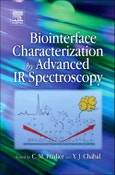IR spectroscopy has become without any doubt a key technique to answer questions raised when studying the interaction of proteins or peptides with solid surfaces for a fundamental point of view as well as for technological applications.
Principle, experimental set ups, parameters and interpretation rules of several advanced IR-based techniques; application to biointerface characterisation through the presentation of recent examples, will be given in this book. It will describe how to characterise amino acids, protein or bacterial strain interactions with metal and oxide surfaces, by using infrared spectroscopy, in vacuum, in the air or in an aqueous medium. Results will highlight the performances and perspectives of the technique.








